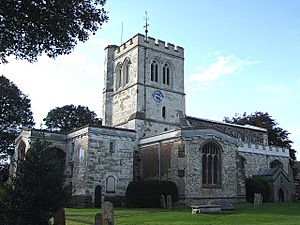Thomas Wentworth, 5th Baron Wentworth facts for kids
Quick facts for kids
The Lord Wentworth
|
|
|---|---|
| Member of Parliament for Bedfordshire |
|
| In office April 1640 – November 1640 |
|
| Personal details | |
| Born | 2 February 1612 (baptised) Toddington, Bedfordshire |
| Died | 1 March 1665 (aged 52–53) Toddington, Bedfordshire |
| Resting place | Church of St George, Toddington, Bedfordshire |
| Spouse | Philadelphia Carey (1658–his death) |
| Children | Henrietta Maria (1660–1686) |
| Parents | Thomas Wentworth, 1st Earl of Cleveland (1591–1667); Anne Crofts (died 1638) |
| Military service | |
| Rank | Major-General |
| Battles/wars | |
Thomas Wentworth, 5th Baron Wentworth (baptised 2 February 1612 – 1 March 1665) was an English nobleman and soldier. He was a strong supporter of the King during the English Civil War. These wars were a series of conflicts in England, Scotland, and Ireland.
After the first part of the Civil War ended in 1646, he went into exile with the future Charles II of England. He continued to fight for the King, including at the important Battle of Worcester in 1651.
Contents
Early Life and Family
Thomas Wentworth was born in 1612. He was the oldest son of the 1st Earl of Cleveland. His mother was Anne Crofts. We don't know his exact birth date. However, church records show he was baptised on February 2, 1612.
In 1640, he became a member of parliament (MP) for Bedfordshire. This happened first in April for the Short Parliament. Then again in November for the Long Parliament. Before he could take his seat in November, he was called to the House of Lords. This was due to a special order called a "writ of acceleration." This meant he took on his father's title, Baron Wentworth, earlier.
He married Philadelphia Carey in March 1658. They had one child together. Her name was Henrietta Maria Wentworth, born on August 11, 1660.
Thomas Wentworth received several important honors. He became a Knight of the Bath. He was also appointed to the Privy Council of England. This was a group of advisors to the King.
Wentworth passed away at age 53 on March 1, 1665. He died two years before his father. He was buried six days later in Toddington, Bedfordshire. His daughter Henrietta Maria inherited his title. After her death, the title went to her aunt, Anne Lovelace.
Fighting in the Civil War
Thomas Wentworth was a key military leader during the First English Civil War. He was a Sergeant-Major-General of Horse. This meant he commanded cavalry units. He fought in many battles alongside his father.
Before the Main War
Before the English Civil War, Wentworth fought in the Bishops' Wars. These wars took place from 1639 to 1640. He fought against the Scottish forces.
Early Civil War Battles
When the Civil War began in 1642, Wentworth was with George Goring in Portsmouth. After Portsmouth fell, he joined the King's main army. He raised a company of "dragoons." These were soldiers who rode horses but fought on foot. He fought in battles at Marlborough in December 1642. He also fought at Cirencester in February 1643.
In February 1643, he became a major-general of dragoons. As the war continued, dragoons became less important. Many of them started acting more like regular cavalry.
So, Wentworth changed roles too. In February 1644, he became the colonel of the Prince of Wales's Regiment of Horse. At the Battle of Cropredy Bridge in June 1644, he led a cavalry brigade. He then became major-general of horse. This happened after Lord Wilmot was removed from his position.
Later, in November 1644, Wentworth left this role. He joined Lord Goring's army in the west of England. After Goring's army was defeated, Wentworth became major-general of horse under Lord Hopton. However, Hopton's army was badly beaten at Torrington in March 1646. This led to the surrender of the western army.
Life in Exile
Wentworth managed to escape with Prince Charles in the spring of 1646. They first went to the Isles of Scilly. Then they moved to Jersey. In 1649, Wentworth went with Charles to Paris.
The Third Civil War
In 1650, both Wentworth and his father sailed with Charles to Scotland. Charles had to agree to certain conditions to be recognized as King. Many of his followers, including Wentworth, did not agree to these terms.
Even after the Scottish army was defeated at Dunbar in September 1650, Wentworth and his father stayed. They ignored orders to leave the country. They fought at the Battle of Worcester in September 1651. This was a major battle. While his father was captured, Wentworth escaped safely.
With the King in Exile
Wentworth stayed with King Charles II's court in exile. This lasted until the King returned to England in 1660.
In 1656, in Bruges, Wentworth helped organize a regiment of foot guards. These soldiers served as bodyguards for the exiled King. This regiment also fought with the Spanish army. They were at the Battle of the Dunes in June 1658. It's not certain if Wentworth personally fought in this battle.
The King's Return
After the King returned to England in 1660, Wentworth came home too. He brought his regiment of foot guards with him. This regiment later became known as the Grenadier Guards.
See also
- Cavalier
- Horses in warfare


